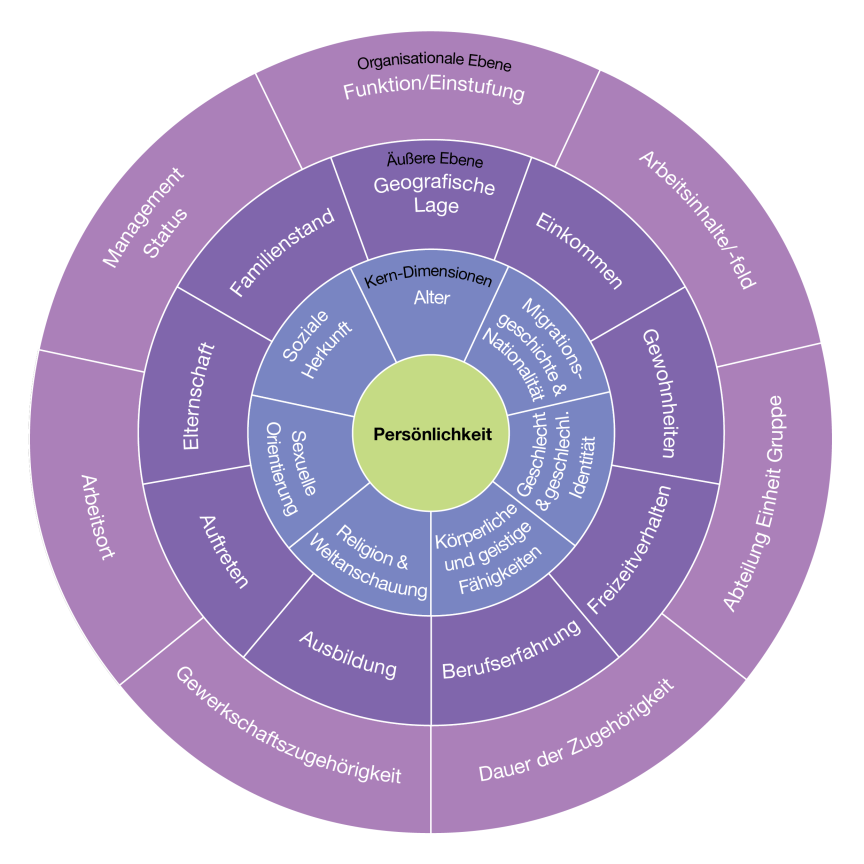The dimensions of diversity

The Diversity Charter bundles seven diversity dimensions that are most closely linked to an individual's personality: Age, migration history & nationality, gender & gender identity, physical & mental abilities, religious & ideological beliefs, sexual orientation and social background.
In addition to these core dimensions, external dimensions such as income and professional experience are also relevant. In contrast to the core dimensions of diversity, these are much more changeable. The holistic nature of diversity as well as intersectionality, i.e. the interaction of several identity characteristics, must be taken into account.
Dimensions of diversity
Age
The core dimension of age refers to employees of different ages, from young career starters to experienced professionals - i.e. Traditionals, Baby Boomers and Generations X, Y and Z. Different generations often have different characteristics, perspectives and value systems, which brings challenges but also opportunities. It is important to recognize the skills and perspectives of all age groups, to ensure the transfer of knowledge between the generations and to pursue a life-phase-oriented HR policy.
Example measures: Set up age-appropriate workplaces, introduce mentoring or knowledge transfer programs, introduce health management.
Migration history & nationality
The diversity dimension of migration history & nationality describes people of different cultural backgrounds, nationalities and skin colors. This is about valuing people of different national and ethnic origins, overcoming prejudices and promoting intercultural skills. Diversity and a prejudice-free working environment in this dimension enriches companies through different perspectives, creativity and innovative strength.
Example measures: Diverse team composition, offering intercultural training, promoting language training.
Gender & gender identity
The gender and gender identity dimension aims to achieve equality and promote all genders in the professional context. It is about overcoming stereotypes and building a corporate culture that ensures equal career opportunities and pay for all genders and gender identities. Raising awareness of gender diversity and creating flexible working conditions as well as equal opportunities and acceptance are important aspects of this dimension.
Example measures: Making recruitment and promotion processes gender-sensitive, gender-mixed teams, management training with a focus on unconscious bias.
Physical & mental abilities
The inclusion of people with disabilities, chronic illnesses or neurodivergent people is the focus of this dimension. The aim is to remove barriers, improve accessibility and adapt the working environment so that all employees can fully develop their abilities. Awareness-raising and specific support services help to promote an inclusive working environment.
Example measures: Supporting young people with severe disabilities in their training, cooperating with organizations for the disabled, setting up barrier-free workplaces.
Religion & worldview
The Religion & Belief dimension refers to the recognition and inclusion of different faiths, spiritual and secular beliefs. Companies that take this dimension into account create a culture of openness, tolerance and respect in which religious and ideological needs are accommodated and accepted.
Example measures: Setting up spaces of silence, adapting canteen offerings to religious customs, observing religious holidays (e.g. when planning vacations or important meetings).
Sexual orientation
This dimension includes the recognition and support of queer people in the workplace. Companies should create an atmosphere of acceptance in which employees can live their identity and personality openly - without fear of discrimination. Diversity-conscious guidelines and open communication are essential for this.
Example measures: Initiate an LGBTQ*IQ network; conduct an inventory to identify and eliminate discrimination.
Social background
Social background refers to the different life and educational backgrounds that people bring to the world of work. Unfortunately, social background still has an influence on educational and labor market opportunities today. Recognizing this diversity means promoting equal opportunities, eliminating prejudice and recognizing and utilizing talent regardless of socio-economic background.
Example measures: Supporting people with low levels of education in their training, mentoring program for employees from non-academic households, involving social enterprises and initiating joint projects.
Contact us
Melanie Albrecht
Hanover Region
Economic Development
Department of Economic Development and Employment Promotion

Finja Hartwig
Hanover Region
Economic Development
Department of Economic Development and Employment Promotion

